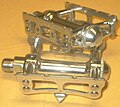Bicycle pedal
Bicycle pedal is a fundamental component of a bicycle, serving as the main contact point between the cyclist and the bike. It provides the mechanism through which the rider's leg power is transferred to the drivetrain, propelling the bicycle forward. Bicycle pedals are typically paired and attached to the crankset, allowing for efficient power transfer from the cyclist to the wheels.
History[edit]
The invention of the bicycle pedal is a key development in the history of bicycles. Early bicycles, such as the dandy horse or velocipede, lacked pedals and were propelled by the rider's feet pushing against the ground. The introduction of pedals, attributed to Pierre Lallement in the 1860s, revolutionized bicycle design and efficiency, leading to the widespread adoption of bicycles as a mode of transportation.
Types of Bicycle Pedals[edit]
There are several types of bicycle pedals, each catering to different riding styles, preferences, and disciplines:
- Platform Pedals: These are the most basic type of pedals, consisting of a flat surface for the foot to push against. They are commonly found on casual or entry-level bicycles and are suitable for riders who prefer easy foot placement and removal.
- Clipless Pedals: Contrary to what the name suggests, clipless pedals allow the rider's shoes to 'clip' into the pedal for a secure connection. This design offers improved efficiency and control, especially in competitive cycling. Clipless pedal systems require compatible shoes and cleats, which can be specific to the pedal brand or model.
- Toe Clip Pedals: These pedals feature a cage or strap that encloses the front of the foot, securing it to the pedal. Toe clips provide some of the benefits of clipless pedals, such as increased power transfer, without the need for special shoes.
- Combination Pedals: These pedals offer a platform on one side and a clipless mechanism on the other, providing versatility for riders who switch between casual and performance-oriented cycling.
Materials and Construction[edit]
Bicycle pedals are constructed from a variety of materials, including plastic, aluminum, and carbon fiber, each offering a balance of strength, durability, and weight. The choice of material often depends on the pedal type and intended use, with higher-end models favoring lightweight and strong materials to enhance performance.
Maintenance and Safety[edit]
Regular maintenance of bicycle pedals is essential for safe and efficient cycling. This includes checking for wear, ensuring that the pedals are securely fastened to the crank arms, and lubricating moving parts. Additionally, using pedals that are appropriate for the rider's style and the cycling conditions can significantly reduce the risk of accidents and injuries.
Environmental and Health Benefits[edit]
Cycling, facilitated by components like the bicycle pedal, offers significant environmental and health benefits. It provides a low-impact form of exercise, contributes to cardiovascular health, and reduces reliance on fossil fuels, thereby lowering carbon emissions.
Bicycle pedal gallery[edit]
-
13-01-06-fahrradkram-05
-
Well-Go Platform bicycle pedal
-
Bicycle pedal, quill type, early 1980s, Campagnolo SL road
-
Trackcage
-
Shimano SPD pedal PD-M520
-
LOOK Keo Blade Carbon clipless pedals
-
Eggbeater mxr - crank brothers
-
But rowerowy SPD
-
Xpedo M-FORCE 4 TI
-
Magnet Pedal
Ad. Transform your life with W8MD's Budget GLP-1 injections from $75


W8MD offers a medical weight loss program to lose weight in Philadelphia. Our physician-supervised medical weight loss provides:
- Weight loss injections in NYC (generic and brand names):
- Zepbound / Mounjaro, Wegovy / Ozempic, Saxenda
- Most insurances accepted or discounted self-pay rates. We will obtain insurance prior authorizations if needed.
- Generic GLP1 weight loss injections from $75 for the starting dose.
- Also offer prescription weight loss medications including Phentermine, Qsymia, Diethylpropion, Contrave etc.
NYC weight loss doctor appointmentsNYC weight loss doctor appointments
Start your NYC weight loss journey today at our NYC medical weight loss and Philadelphia medical weight loss clinics.
- Call 718-946-5500 to lose weight in NYC or for medical weight loss in Philadelphia 215-676-2334.
- Tags:NYC medical weight loss, Philadelphia lose weight Zepbound NYC, Budget GLP1 weight loss injections, Wegovy Philadelphia, Wegovy NYC, Philadelphia medical weight loss, Brookly weight loss and Wegovy NYC
|
WikiMD's Wellness Encyclopedia |
| Let Food Be Thy Medicine Medicine Thy Food - Hippocrates |
Medical Disclaimer: WikiMD is not a substitute for professional medical advice. The information on WikiMD is provided as an information resource only, may be incorrect, outdated or misleading, and is not to be used or relied on for any diagnostic or treatment purposes. Please consult your health care provider before making any healthcare decisions or for guidance about a specific medical condition. WikiMD expressly disclaims responsibility, and shall have no liability, for any damages, loss, injury, or liability whatsoever suffered as a result of your reliance on the information contained in this site. By visiting this site you agree to the foregoing terms and conditions, which may from time to time be changed or supplemented by WikiMD. If you do not agree to the foregoing terms and conditions, you should not enter or use this site. See full disclaimer.
Credits:Most images are courtesy of Wikimedia commons, and templates, categories Wikipedia, licensed under CC BY SA or similar.
Translate this page: - East Asian
中文,
日本,
한국어,
South Asian
हिन्दी,
தமிழ்,
తెలుగు,
Urdu,
ಕನ್ನಡ,
Southeast Asian
Indonesian,
Vietnamese,
Thai,
မြန်မာဘာသာ,
বাংলা
European
español,
Deutsch,
français,
Greek,
português do Brasil,
polski,
română,
русский,
Nederlands,
norsk,
svenska,
suomi,
Italian
Middle Eastern & African
عربى,
Turkish,
Persian,
Hebrew,
Afrikaans,
isiZulu,
Kiswahili,
Other
Bulgarian,
Hungarian,
Czech,
Swedish,
മലയാളം,
मराठी,
ਪੰਜਾਬੀ,
ગુજરાતી,
Portuguese,
Ukrainian










